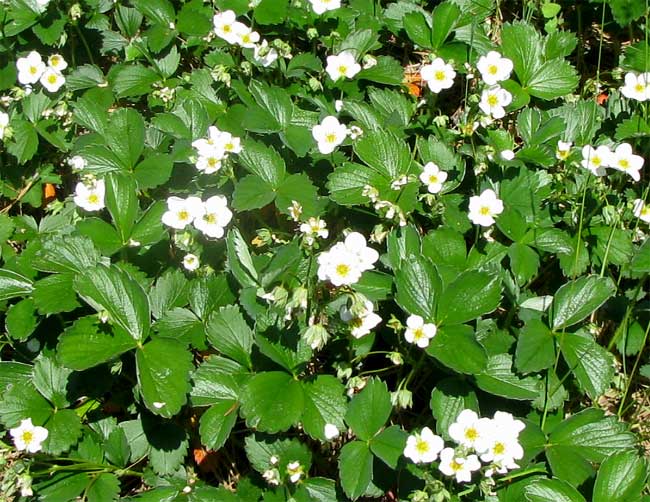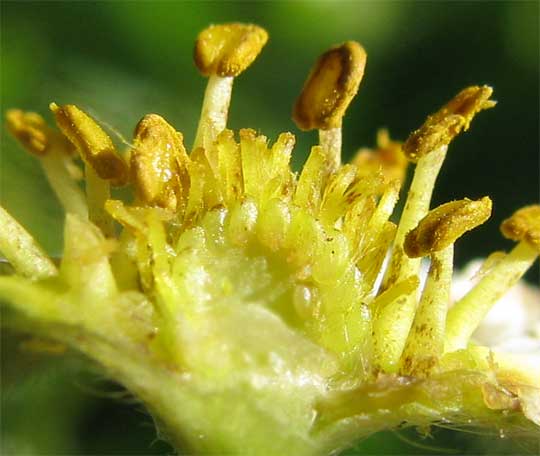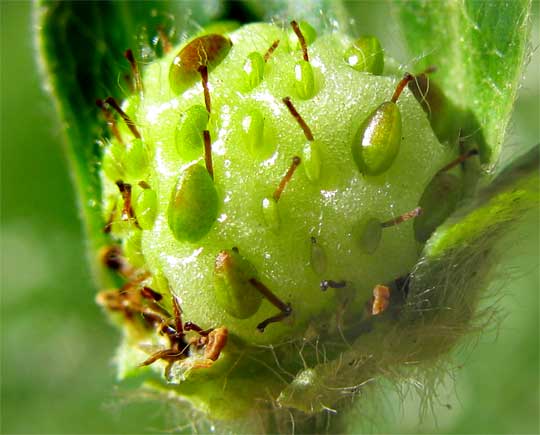Excerpts from Jim Conrad's
Naturalist Newsletter

from the the May 31, 2009 Newsletter, issued from the Siskiyou Mountains west of Grants Pass, Oregon:
LOOKING AT STRAWBERRY FLOWERS
Behind my friends' house there's a slope absolutely covered with flowering strawberry plants. A small section showing white flowers and trifoliate leaves is shown above. Unfortunately, the abundant harvest the blossoms seem to promise never develops. The flowers simply dry up and fall off. The reason is that the plants haven't been cultivated for years, but a strawberry plant produces good fruit for only two or three years. New plants produced at the rooting tips of a mother plant's stolons can be transplanted and those daughter plants will produce large fruits if properly cultivated, but no matter how well the mother plant is taken care of, it loses its vigor once it's issued its share of stolons. We've transplanted lots of young plants to new beds so before long we should have plenty of fresh strawberries.
Strawberry "fruits" are bizarre things but they can be understood by looking at the flowers from which they come. In the world of flowers, the simplest blossoms are those containing a single pistil, comprising the stigma, style and ovary -- the female parts. You may want to review basic flower structure at http://www.backyardnature.net/fl_stand.htm.
Individual strawberry flowers depart from that basic one-pistil arrangement by bearing many pistils. A diagram showing the two different configurations -- a flower with one pistil and another with many -- is at http://www.backyardnature.net/pix/pistil.gif.
Take a look at the strawberry flower cross-section below:

The tallest items topped by golden horseshoe thingies are pollen-producing male stamens. Notice how they arise around the female parts in the flower's center. So far that's like our Standard Blossom. Now notice that at the very center of the flower I've cut across a little hill composed of nothing but undifferentiated tissue, and covering the hillock are numerous oval, shiny things. Each shiny thing is topped by a slender, yellow, matchstick-like item. The shiny things are ovaries and the sticklike things are stigma-tipped styles -- in other words, the little hill is covered with many pistils. The hillock in the picture's center is called the receptacle.
So, here's the thing: Unlike our Standard Blossom, a single strawberry flower's receptacle bears many pistils.
In most flowers the pistil matures into the fruit. With strawberry flowers there's a whole different story. Look at the next close-up, which shows an older flower after the white petals have fallen off, below:

In that picture the receptacle is beginning to enlarge tremendously causing the pistils to become more and more separated from one another. The spongy-looking sphere is the receptacle. The pistils themselves are maturing into special kinds of fruits called achenes, which are dry, one-seeded fruits that don't split open upon maturity. The sunflower "seeds" we eat also are achenes. Each achene in the picture is accompanied by the brown, shriveling-up remains of its stigma-tipped style. At the bottom of the spongy receptacle you can see remains of shriveled stamens.
So, you can already guess that the green, spongy receptacle in the above picture is going to enlarge even much more, eventually will turn soft, juicy and red, and when we bite into that receptacle, the strawberry, the soft-gritty little things that may get stuck in our teeth are achenes, which are the actual strawberry fruits we'd sow if we wanted to grow strawberries from seed.